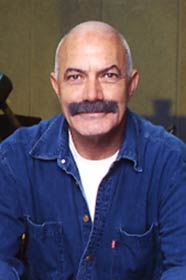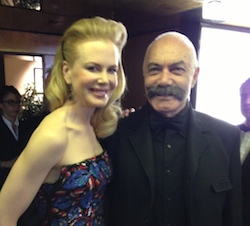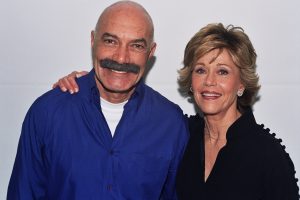The fabled “King of the B’s” producer and director churned out low-budget genre films with speed and provided career boosts to young, untested talents like Jack Nicholson, Ron Howard, Peter Bogdanovich, Scorsese, Coppola, Jonathan Demme, Gale Anne Hurd and James Cameron.

Roger Corman, the fabled “King of the B’s” producer and director who churned out low-budget genre films with breakneck speed, has died. He was 98.
Corman provided career boosts to young, untested talents like Jack Nicholson, Ron Howard, Peter Bogdanovich, Martin Scorsese, Francis Ford Coppola, Jonathan Demme, Gale Anne Hurd and James Cameron,
The filmmaker, who received an honorary Oscar in 2009 at the Governors Awards, died Thursday, May 9, at his home in Santa Monica, his daughter Catherine Corman told the AP.
“He was generous, open-hearted and kind to all those who knew him,” the statement said. “When asked how he would like to be remembered, he said, ‘I was a filmmaker, just that.’”
He also achieved notoriety for producing The Trip (1967), which starred Peter Fonda as a man on an LSD-inspired odyssey. Its controversy delighted Corman, who was one of the first producers to recognize the power of negative publicity.
His blend of sex, nudity, violence and social themes was taken seriously in many quarters, especially in Europe and among film school professors, and in 1964 he was the first American producer-director to be honored at the Cinematheque Francaisee with a retrospective of his movies.
Others considered his work so embarrassingly awful that it deserved lasting notoriety. Take Bloody Mama (1970), for instance; sure, it was a gangster saga about Ma Barker and her thug sons, but the cast included Shelley Winters, Robert De Niro and Bruce Dern.
There are two divergent schools of thought on Corman’s career: 1) That he recognized and nurtured talent or 2) that he exploited youthful talent and never used it to go beyond the rudiments of pushing out quickie product.
Nicholson, then 21, made his big-screen debut in Corman’s The Cry Baby Killer (1958).
Corman hired a young Scorsese to direct Boxcar Bertha (1972) and Demme to write Caged Heat (1974).
He made new college graduate Hurd his production assistant and later his marketing chief and handed Cameron the job of designing props for Battle Beyond the Stars (1980).
All are proud members of “The Roger Corman School of Filmmaking.”
Roger William Corman was born on April 5, 1926, in Detroit, but his family–including late younger brother Gene, who went on to become an agent and produce several movies–moved to Beverly Hills when he was 14.
He attended Beverly Hills High School and graduated from Stanford University in 1947 with a degree in industrial engineering, which he said fostered the type of thinking needed in low-budget production.
He served in the U.S. Navy for nearly three years but found when he was discharged that he had lost his taste for engineering. He took a job at 20th Century Fox as a messenger and worked his way up to story analyst.
Frustrated with that position, he quit and set off for England. He attended Oxford, doing graduate work in English literature. Ultimately, he went on to Paris, where he sold freelance material to magazines. When he returned to the U.S., he worked as a literary agent. Inspired by the utter awfulness of the scripts he read, he decided to try his hand at writing.
“I said to myself that this looked like an easy way to make a buck, so I sat down and spent a lot of nights doing a script called Highway Dragnet,” he once recalled. He sold the script to Allied Artists for $4,000, and it was made into a movie starring Joan Bennett and Richard Conte.
He delighted in making genre films, beginning with Westerns: Five Guns West (1955) was his first directing credit, and he followed with Apache Woman (1955) and The Oklahoma Woman (1956). He switched to science fiction and horror, blasting out such gobbled fare as Day The World Ended (1956), It Conquered the World (1956), The Undead (1957), Night of the Blood Beast (1958) and She Gods of Shark Reef (1958). Amid the bloodletting, hokey costumes and bizarre plots were bursts of cheeky humor and campy signs of intelligent life, reflecting Corman’s breezy, comic sensibility.
Inventive and calculating, Corman learned how to cash in on topical issues: After the Soviet Union launched Sputnik, he made War of the Satellites (1958). He capitalized on the rock ’n’ roll rebellion, with such teen pics as Rock All Night, Teenage Doll and Carnival Rock, all released in 1957.
The reviews were disparaging, but his movies turned a profit. His autobiography, How I Made a Hundred Movies in Hollywood and Never Lost a Dime, was first published in 1990.
Not deterred by the ignominy of not being associated with a major studio, the maestro at inexpensive moviemaking continued to serve up lethal does of humor and horror, including A Bucket of Blood (1959) and Little Shop of Horrors, a spoof of horror films that Corman intentionally shot in two days to break a production record. His other work included such schlockers as Creature From the Haunted Sea (1960), Battle of Blood Island (1960) and Last Woman on Earth (1960).
Corman ventured into weightier territory, producing The Intruder (1962), a hard look at racial prejudice. It was his first “message” film, and he financed it himself when the major distributors balked at the subject. The story centered on a hatemongering racist (William Shatner) who organized violent opposition to court-ordered school desegregation. It used the N-word in realistic, non-gratuitous manner, but the film was denied the Production Code’s seal and screened in few movie houses.
He signed a deal with Columbia Pictures in the mid 1960s but grew dissatisfied with its low-budget assignments and returned to AIP to do The Wild Angels. Made on a reported budget of $360,000, it grossed more than $25 million.
After Bloody Mama, he withdrew from directing to form New World Pictures, a production and distribution company geared to low-budget, campy movies aimed at young audiences.
Despite industry ridicule, his formulaic send-ups made money, Women in Cages (1971), The Velvet Vampire (1971) and Night Call Nurses (1972).
Corman had certain aesthetic rules and qualitative guidelines: “In science fiction films, the monster should be always be bigger than the leading lady.” He pioneered such cinematic staples as the girls’ shower scene, usually the second scene in a Corman teen film. He insisted his directors practice proper professionalism: namely, always have the girls lather up their arms and stomachs so as not to obscure the integrity of the breast shots.
Corman then switched gears, distributing foreign art films that the majors were too timid, or too weighted down by marketing wisdom. He used mass marketing sensibility to release Bergman’s Cries and Whispers (1972), Fellini’s Amarcord (1974), Truffaut’s The Story of Adele H. (1975), Kurosawa’s Dersu Uzala (1975), Herzog’s Fitzcarraldo (1982).
He had producing credit on more than 400 projects, including Attack of the 50ft Cheerleader (2012) and the TV movie Sharktopus vs. Pteracuda.
His graduates have cast him in cameo roles, Coppola in The Godfather: Part II (1974) and Demme in The Silence of the Lambs (1991), Philadelphia (1993) and Rachel Getting Married (2008).
In his Oscar acceptance speech, Corman applauded those who take chances. “Many of my friends and compatriots and people who’ve started with me are here tonight, and they’ve all succeeded,” he said. “Some of them succeeded to an extraordinary degree. And I believe they’ve succeeded because they had the courage to take chances, to gamble.










